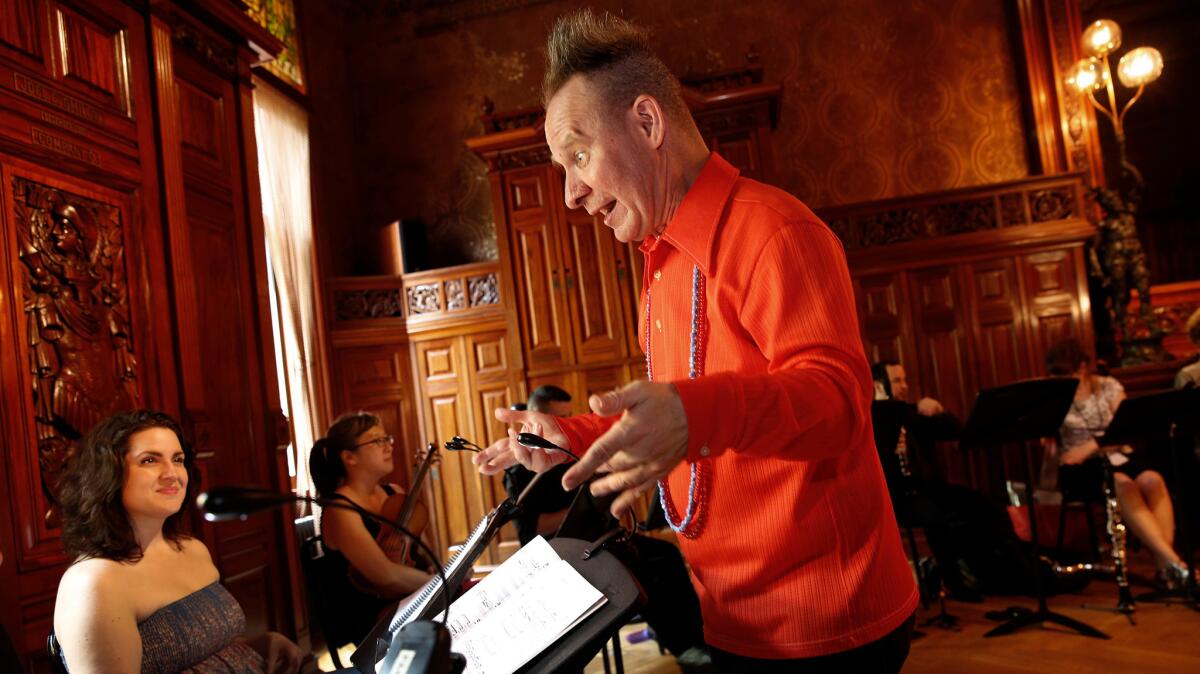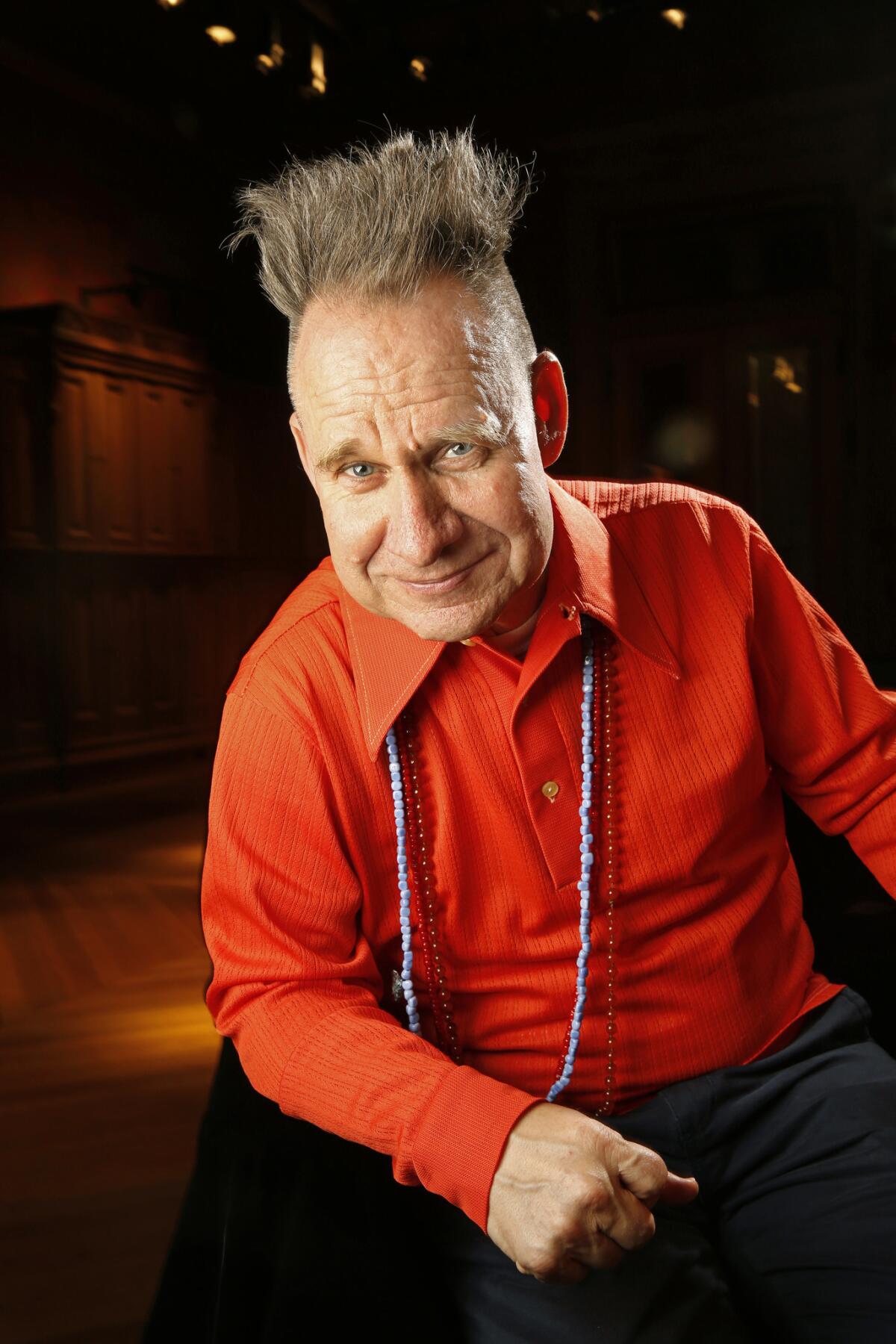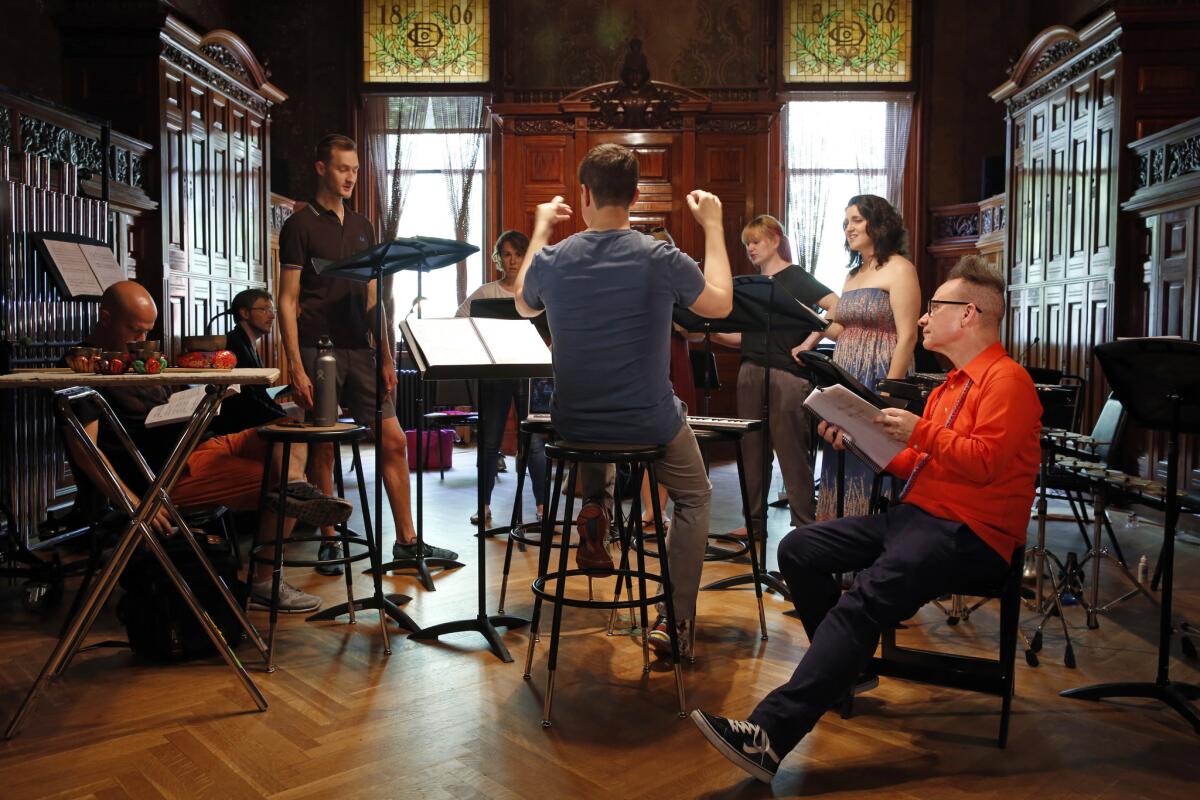Column: Peter Sellars jump-starts the conversation at the Ojai Music Festival

The Ojai Music Festival has always had, at its center, conversation. Intimacy and informality have had something to do with that. This is a small town in a spiritually quirky setting — idyllic, idealistic, numinous and, well, odd.
The natural surroundings of the modest amphitheater, the Libbey Bowl, encourage gathering while the stimulating and challenging programming that Ojai is known for gives its usually tolerant audiences something to discuss. But there are other kinds of conversation a festival can offer.
Peter Sellars, who is this year’s music director, is a conversationalist if ever there was one. He likes to talk (and will before every major program). He likes to provoke others to talk (and he’ll be doing that before every major program as well). But he further sees his job as a festival director to get artworks to talk to one another and our job as an audience to eavesdrop. As a crusading theater artist, Sellars is also in conversation with artists about the staging of works and especially about the creation of new ones.
Finally, and crucially for Sellars, there is the conversation between Ojai, with its long history of spiritual and artistic retreat, and the outside world. This is pure Sellars, who as a director of festivals as well as of opera and theater, has made it his main business to engage in the other, in investigating the far-flung implications of motivating forces.
In Sellars’ Culver City home, where we meet for a conversation about the Ojai festival beginning Thursday and running through Sunday, bookshelves rise to the top of high ceilings and more books are in piles. The decor includes objects, many with spiritual context, from African, Indian and Asian cultures. An old poster from the Los Angeles Festival that Sellars headed in the early ’90s hangs on a rare wall where a bookcase won’t fit. He lives in what feels like a constant conversation between ideas and between cultures.
He also lives in actual conversation. The phone doesn’t stop ringing and his mantra of “I can’t deal with that now.” A filmmaker is leaving as I arrive.

Sellars says his starting point was not chatter but Ojai itself, the region originally settled by the Chumash Nation and also known, in popular culture, as the Shangri-La of the 1937 movie “Lost Horizon.” That is to say Ojai as a place where the conversation is that of inner contemplation not external engagement, where we listen to what the environment has to tell us.
“My point of view is to talk about what the landscape invites as a response,” Sellars explains. “The way the programs are put together has to do with dream cultures and a bunch of things that are I think reflected in this place.”
The result is a festival far-flung with points of reference to Ojai’s light as a generator of meditative and mystic traditions. Key works, however, revolve around the great difficulty and even moral ambiguity of mystic retreat or, at the very least, the excess of idealism. Excess of idealism is something Sellars knows much about, having headed festivals in Adelaide, Australia, and in Vienna and elsewhere, where, as with the Los Angeles Festival, he aggressively and controversially pushed boundaries artistically, culturally and philosophically.
Sellars’ featured composer for Ojai is Kaija Saariaho. A close friend of Esa-Pekka Salonen, with whom she went to school in Finland, she has long been known in Los Angeles, but she will be making her first visit to Ojai. Sellars inspired and directed her first opera, “L’Amour de Loin,” given its premiere at the 2000 Salzburg Festival and commissioned by the late Los Angeles (and Ojai) patron Betty Freeman.
Saariaho is known for the gorgeous, hazy textures of her works, and Sellars sees that as being an apt quality for a place where at sunset the surrounding mountains sometimes turn pink. But Sellars warns about getting too literal about surfaces.
“Kaija’s music is very interesting,” he says, “because the structural elements are so frequently buried inside this beautiful gauzy surface that is indeterminate, that keeps morphing in ways that defy immediate description.” That gauze will pervade afternoon concerts of her chamber music Friday and Saturday, but there are darker elements as well.
The festival opens Thursday night with a new Sellars staging of Saariaho’s unnerving “La Passion de Simone,” which had its premiere at Sellars’ New Crowned Hope Festival in Vienna in 2006. A work for a solo soprano and orchestra (here it will be in Saariaho’s new version for chamber orchestra), it questions the deepest consequences of French philosopher and mystic Simone Weil’s selfless actions during World War II. A member of the French Resistance in London, she denied herself any more food than the Germans provided prisoners. Already in poor health, she died of starvation at age 34 in 1943.
Originally written for Dawn Upshaw, who sang it in 2009 with Salonen and the Los Angeles Philharmonic in Walt Disney Concert Hall, the piece has been taken up by an Upshaw protégé, Julia Bullock.
“I thought I knew this piece,” Sellars says, having just staged it in Berlin with Bullock. “I helped shape it and I’ve directed in in eight countries. But she has taken it to some other places.”
The original staging for Upshaw included prerecorded spoken text and also a dancer. Bullock does it all herself on stage. “And the piece,” Sellars exclaims, “has been transformed.
“It is like a Black Lives Matter activist picking up a book by Simone Weil and being deeply affected by it, recognizing what it means when you devote your life to this kind of activism. But then how do you end up treating your family?”
For Sellars, Bullock exposes the critical dichotomy of recognizing the truth in a troubling political situation but questioning what is productive and what is counterproductive. “Do we really have to do this now?” he seems to be asking himself of a political activism that he has always promoted.
“The struggle hasn’t changed. In fact it is more exacerbated than ever. But to have African American regard towards Simone Weil is really powerful.” Thus the conversation begins.
The next night in Ojai, Egyptian singer Dina El Wedidi takes up the theme. “Dina is not exactly a picture of activism,” Sellars says. “Like most people in Egypt right now, she has to reach beyond the political context. As you know, there’s a lot of violence, so Dina is about a longer strategy of living well and living longer until there is another set of openings.
“Her singing is not political but about how not to lose your taste for life. Her ensemble is very oriented to pleasure and not ruining your life with a futile all-or-nothing gesture.”
For Sellars there can be no all or nothing, as the conversation gets increasingly intertwined and the context keeps changing. Saturday night Bullock turns to the American chanteuse and Parisian star, Josephine Baker, who, like Weil, was involved in the French Resistance. The year Weil died, Baker refused to sing for King Farouk in Cairo because Egypt had remained neutral in the Second World War. Added to this conversation, Sellars says, will be the arrangements of Baker songs by avant-garde jazz percussionist Tyshawn Sorey, who resists positioning himself exclusively in the African American jazz tradition, and the Jamaican poet Claudia Rankine, whose works examine the political complexities and contradictions of cultural identity.

On the festival’s final afternoon, Sellars turns to an opera by French composer Claude Vivier, who reveals yet another side of Paris. Murdered by a male prostitute in Paris in 1983, he was 34, the same age as Weil when she died. Vivier called “Kopernikus” a mystic tale, and it revolves around a Hindu deity and summons up such figures from Mozart’s “The Magic Flute” and Wagner’s “Tristan and Isolde,” operas Sellars has notably staged.
I show Sellars a note Freeman had left in the case of a DVD featuring a Dutch National Opera production of “Kopernikus” she had asked to borrow. I discovered the note after Freeman’s death in 2009. “It all sounds like dogs howling,” she wrote of a work that stretches vocal traditions. Sellars laughs boisterously reading it. But he says the opera has been misinterpreted by European modernism.
“For me, ‘Kopernikus’ is waiting to be heard the way we can hear it in California after the Los Angeles Festival, where we brought ensembles from Bali. I know what the prayers are in a Balinese cremation ceremony. None of it is nonsense language, all of it is a prayer, what you would want your grandmother to have in her ears on her last moments on Earth.”
Everything, of course, is connected. Sellars says his great disappointment is not being able to bring Saariaho’s latest opera, “Only the Sound Remains.” It was, ironically, commissioned by Dutch National Opera and Sellars staged its premiere in Amsterdam two months ago. He announced the U.S. premiere for Ojai, but the work turned out to be too musically complex to prepare for Ojai. Still he is making up for another disappointment with “Kopernikus,” which Sellars had planned to produce this spring with the Berlin Philharmonic, where he serves this season as artist in residence along with his many other projects — including developing a new opera with John Adams about the California Gold Rush from the women’s perspective. The “Kopernikus” in Berlin became, as had “Only the Sound Remains” in Ojai, impractical to schedule and had to be canceled, so Ojai will get it first.
Everything is also connected in ways that can’t be known in advance. Sellars is flooding Ojai with new music. He will introduce Leila Adu, a young singer, pianist and composer whom he describes as someone who writes fantasies for her voice on Buddhist mantras as well as songs about what black life feels like in this country. Sellars describes her as “this raw, direct presence of a woman at the piano putting down some chords and some short strong words that repeat and then vanish.”
The dominance of women at the festival has been much noted, but Sellars dismisses it. Yes, there will be a new piece by Pulitzer Prize-winner Caroline Shaw. She is also a member of the vocal ensemble Roomful of Teeth, which will be in residence along with ICE, the International Contemporary Ensemble headed by flutist Claire Chase, who initiated several of the projects and commissions, including the chamber version of “Simone.”
New works have been commissioned from Tania Leon and Sharon Hurvitz for a project that brings together Youth Orchestra LA and ICE at a free family concert Sunday afternoon. Sonic meditations by Pauline Oliveros welcome the Saturday and Sunday mornings. South Indian vocalist Aruna Sairam reminds us that the Ojai Valley was central to the life and thought of Indian philosopher Krishnamurti, who died there in 1986 and whose influence is still felt in the area.
But Sellars says it is not about being a women’s festival — although he has also invited renowned feminist musicologist Susan McClary to join him in his preconcert talks with the artists — but rather being about following lines of thought. “A festival is itself an art form,” he contends. “A certain alchemy takes over where everything escapes its boundaries with unexpected convergences, and you go to a higher math where two plus two doesn’t equal four but a much higher number.”
That is the equation for the finale Sunday, which has caused a commotion rare for a place that thinks of boundary breaking and tradition defying as the norm. Rather than a grand finale concert late Sunday afternoon in Libbey Bowl, Sellars will move everything to the old town of Santa Paula a half hour and a world away from Ojai for a free street party with festival performers interacting in their expectedly unexpected ways.
“Sunday is going to be a gesture of what a festival can be, which is to create this common ground,” Sellars concludes, “and where to find out what is conversation and what is simply your own isolated vector.”
The biggest entertainment stories
Get our big stories about Hollywood, film, television, music, arts, culture and more right in your inbox as soon as they publish.
You may occasionally receive promotional content from the Los Angeles Times.








